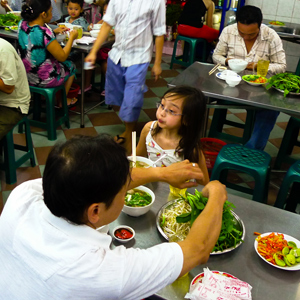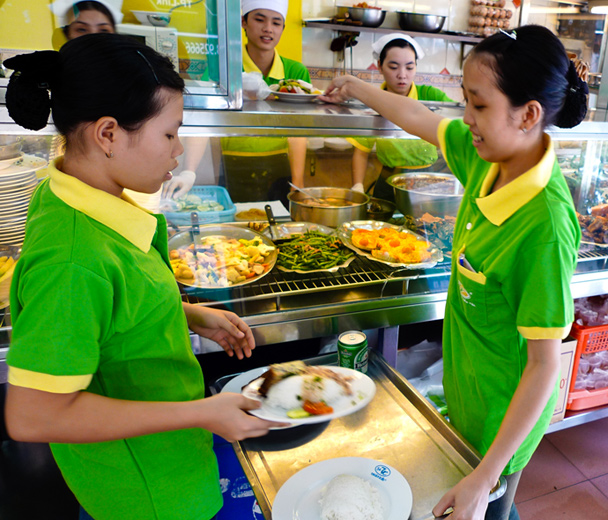I never learned Vietnamese as well as I should have. I lived in Ho Chi Minh City for a post-college year in 1996 and 1997, and by the time I returned to America, I had completed approximately three weeks of official language study. Most of what I learned, I learned on the streets, and most of that concerned food, since Vietnamese food—the myriad noodle soups, the grilled meats and exotic fruits, the heavenly pungency of fish sauce—had been my primary reason for moving to the former Saigon. I knew how to order bún bò Huế a very spicy beef noodle soup, and I could identify the herbs served alongside it, but politics, gossip—even the weather—were beyond my conversational abilities.
Which may explain why, one day during a return visit in 1999, I felt so unsure of myself. I was standing on a sidewalk downtown, around the corner from the war-famous Rex Hotel and the French Colonial Opera House, trying to find a ride. It was just before noon; car and motorcycle traffic was heavy as workers and students headed to homes and restaurants for the two-hour lunch siesta. Bizarrely, though, no taxis.
Nearby, however, a middle-age man sat on his parked Honda Dream, a 100cc moped that’s one of the most popular bikes in the city. Was he a xe ôm—a term for motorcycle taxi that means, literally, “hug bike”—or just a regular guy waiting for a friend? I didn’t want to offend him by asking, but I was getting hungry. “Are you a xe ôm?” I said.
He was! Now it was time to test my language skills further. As he turned the key and started the engine, I climbed on behind him—the “hug” position—and said the words I’d been rehearsing for days: “Tôi muốn ăn sườn nướng ngon nhất ở thành phố. Anh biết đi đấu?” Translation: “I want to eat the best grilled pork chops in the city. Do you know where to go?”
This was not a complicated sentence, but somehow I’d never composed it before. (Idiot!) It might, I imagined, be the key to eating in Ho Chi Minh City, a place where eateries tended to be highly specialized, often focusing on a single dish or related set of dishes. Here, asking for the best spring rolls or best crab restaurant made cultural-culinary sense. What’s more, there were zillions of restaurants, hidden in alleyways and garages and old French villas, and the Vietnamese people who patronized them tended to be highly particular and proud of their preferences. But could I get on a random taxi, ask for the best noodles, barbecued beef, or whatever in town, and eat well? I was about to find out.
My xe ôm set off, following a northerly route that led through neighborhoods I’d never quite noticed before, and deposited me at an open-air restaurant (I’ve forgotten its name) just far enough from a major intersection that it was nearly unnoticeable. As at many Vietnamese restaurants, the tables were close to the ground, and I had to squat on a low plastic stool. My food arrived with no fanfare: a melamine plate of cơm tấm, or broken rice, topped with a thin slab of pork chop, flecks of black char and chopped scallions floating on its film of fat and juices. On the side was a small bowl of nước chấm, a mix of fish sauce, lime juice, sugar, and water. Altogether, this makes cơm sườn nướng, grilled pork chops on rice, easily the most popular lunch item in the city.
I pulled flimsy metal utensils from a container on the table and sawed off a piece of pork with the dull spoon edge, then drizzled it with nước chấm. Then I ate it. This…was…good! The marinade of fish sauce, sugar, garlic, and black pepper had penetrated deeply, and the high heat of the charcoal had caramelized it so quickly that the pork hadn’t had a chance to dry out. Even the broken rice, so named because it’s made from shattered, low-cost grains—it was a peasant staple I’d never cared for before—was just right, absorbing every drop of flavor.
Was this the best in the city? I wasn’t sure. I’d eaten cơm sườn nướng, dozens of times before, some of it quite excellent. But frankly, that didn’t matter. What mattered was that my experiment was a success, and I had a new way to eat in Saigon.
Since then, I’ve returned to Vietnam a half dozen times, and have continued to test my system: I flag down a taxi or a xe ôm, ask for the city’s best whatever, and see what happens. Often, especially in proper taxis, the drivers get really into it. They’ll hop on the radio with dispatch and excitedly debate the possibilities (usually in Vietnamese too sophisticated for me to understand). Then I’ll go where they take me, fielding the usual questions along the way: Where am I from? Am I married? How many kids? What’s my job? How much money do I make? All but the last are easy to answer.
And then they’ll deposit me somewhere I’d never been before. When I asked to eat bún thịt nướng, a cherished bowl of cold rice noodles with grilled pork, a driver took me to a fluorescent-lit restaurant off a major intersection—I’d passed it by who knows how many times. And the dish really was the best I’d had: moist, supple noodles; freshly cooked pork with crushed peanuts; lots of shredded lettuce, cucumbers, and pickled daikon; and, most important, copious amounts of the herbs that make southern Vietnamese cuisine so distinct—shiso-like tía tô, cilantro-esque rau răm, very sharp mint.

Not every interaction was inspired, of course. One rail-thin driver was dumbfounded by my request, and seemed not to know anywhere to eat in Saigon at all. Once, I asked a driver to take me to the best bánh xèo, a rice-flour crêpe filled with pork, shrimp, and bean sprouts. I thought he’d lead me to a place I’d been once before, a rowdy, famous courtyard where they make nothing but bánh xèo, but even though I described it carefully (“Everybody knows it!”), he took me elsewhere, to a far-flung row of gas-fired iron skillets where turmeric-yellow crêpes bubbled ferociously. They were good enough, I suppose, but not great—just like my Vietnamese language skills.
The most challenging request I ever made was also the most rewarding. “I want to eat the best phở in the city,” I told the driver, a man in his late 20s just starting to put on weight. “Do you know where to go?” Normally, this might not seem like a challenge: phở, an aromatic beef noodle soup, is considered Vietnam’s national dish, and is eaten almost every day. But phở is also primarily a breakfast food, and it was now mid-afternoon. Still, the driver was psyched—a foreigner wants to eat the best phở in the city! As we drove southwest, towards Saigon’s Chinatown, he explained how tricky this was. If only it were morning, he said, we could go to District 10—near where he lived, of course—that absolutely had the best phở in town. Alas, traffic was bad, and they were probably closed. But still— phở!—he ate it every day, he was happy I liked it, and he’d bring me somewhere good anyway.
Whether because his diction was simple or because his enthusiasm spoke louder than words, I could actually understand everything he was saying, and I was inspired to attempt a bit of eloquence. “He who likes phở,” I said in grandiose tones, “is my friend!” (It sounds better in Vietnamese.) He laughed—he understood!—and then we arrived at Pho Le, another restaurant I’d always ignored. I invited him to join me for a bowl, but no, he had to work. And anyway, it was long past breakfast.
And so I ate my phở —a marvelous beefy broth, sweet with onions and hints of anise and clove—and wished I’d gotten the driver’s business card. Morning was a mere 15 hours away, and I’d surely be hungry again, for the best breakfast in the city, wherever that might be.
Matt Gross writes the “Getting Lost” series for the New York Times travel section, is a contributing writer at Afar magazine, appears regularly in Saveur, and blogs about parenting at DadWagon.com. When he’s not on the road, he’s with his wife, Jean, and daughter, Sasha, in Boerum Hill, Brooklyn.

